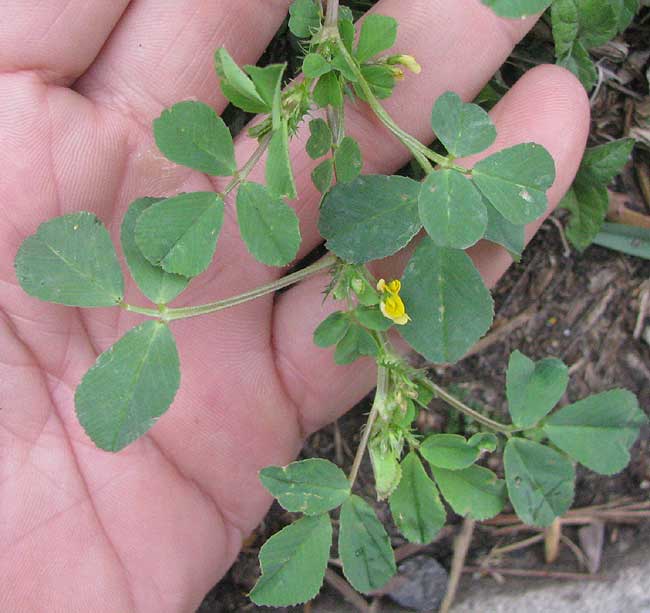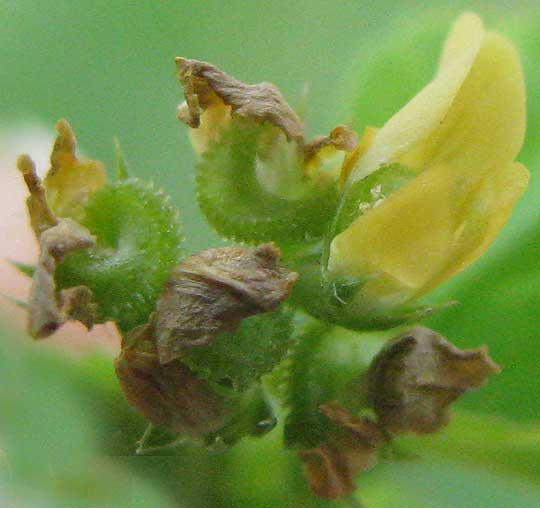Excerpts from Jim Conrad's
Naturalist Newsletter

from the the February 10, 2013 Newsletter issued from the valley of the Dry Frio River in northern Uvalde County, southwestern Texas, on the southern border of the Edwards Plateau; elevation ~1750m (~5750 ft); N29.62°, W99.86°; USA
BUR CLOVER
The clover definitely bore clover-like leaves, but its flowers weren't white or purplish like those of the common clovers back East, nor were its flowers grouped in spherical heads or long spikes like most common clover species. The flowers were yellow and usually only three or four formed a cluster. You can see a sprawling stem of the plant with its few tiny, yellow blossoms above.
So, was this really a clover? Clover species belong to the Bean Family and are members of the genus Trifolium. Trifolium species bear conspicuous stipules, and that's also the case with this species. At the top of the above picture note the slender-toothed stipules encircling the stem where petioles attach to the stem. So, that supports the notion that this is a real clover.
However, pulling a flower cluster closer you can see something that wasn't-clover-like at all, as shown below:

At the right in that picture you see a flower with its five yellow petals arranged in the way you'd expect of a Bean Family member (papilionaceous). Beside that blossom there are also four other flowers who already have been pollinated, their yellow corollas have dried up, turned brown, and are about to fall off, and now where each blossom once stood there's a coiling up green thing covered with low prickles. These are the flowers' ovaries enlarging into spiny, coiled-up fruits, or legumes.
When you see a plant that in every way looks like a regular clover except that it has few flowers per cluster and its maturing ovaries develop into spiny, tightly coiled legumes, you have a bur-clover, a member of the genus Medicago. Our species is MEDICAGO POLYMORPHA, an invasive originally from Eurasia but now scattered across North America and other parts of the world, especially in warmer parts. It goes by such English names as Californian Bur Clover, Toothed Medick, Toothed Bur Clover, Fimbriate Medick, Toothed Medick, and more. The "bur" in these names refers to the prickly legumes which when mature can stick to passing animals' fur for fruit dispersal.
The word medick is an old one, from Middle English medike, which came from the Latin medica, which itself arose from the ancient Greek medike, which was the abbreviated name of Medike poa, which literally meant "Median grass," so called because the plant was imported from Media to Greece during the Greco-Persian Wars from 560 to 500 BCE. At that time the Median Empire occupied a large swath of land extending from present-day Turkey to Pakistan.
About 83 species of the "medick" genus Medicago are recognized, of which Alfalfa, Medicago sativa, is the most famous. Field marks distinguishing our Medicago polymorpha in Uvalde from most other Medicago species include its stipules' long, slender teeth and the spines on its loosely coiled legumes.
The species is regarded as a good forage plant, though some might say it can't beat its cousin Alfalfa.
Ecologically, root nodules on Medicago polymorpha harbor the bacterium Sinorhizobium medicae, which is capable of nitrogen fixation, the nitrogen fixed being made available as a critical nutrient to other organisms in the ecosystem